It is widely understood that many males fail to be satisfied with sexual relations that are confined to their wives and would like to make at least occasional contacts with females to whom they are not married. While it is generally realized that there are some females who similarly desire and actually engage in extra-marital coitus, public opinion is less certain about the inclination and behavior of the average female in this regard.
Most males can immediately understand why most males want extramarital coitus. Although many of them refrain from engaging in such activity because they consider it morally unacceptable or socially undesirable, even such abstinent individuals can usually understand that sexual variety, new situations, and new partners might provide satisfactions which are no longer found in coitus which has been confined for some period of years to a single sexual partner. To most males the desire for variety in sexual activity seems as reasonable as the desire for variety in the books that one reads, the music that one hears, the recreations in which one engages, and the friends with whom one associates socially. On the other hand, many females find it difficult to understand why any male who is happily married should want to have coitus with any female other than his wife. The fact that there are females who ask such questions seems, to most males, the best sort of evidence that there are basic differences between the two sexes (Chapter 16 ).
Since extra-marital coitus can exist only where there is an institution of marriage, there is nothing strictly comparable to it among man’s mammalian ancestors, although a rather similar phenomenon may develop in any species of animal which establishes sexual partnerships that last through at least one full breeding season. Such more or less prolonged relationships exist among many of the primates (the monkeys and apes) and among some of the other larger mammals such as sea lions, elephants, some of the dogs, beaver, horses, deer, and still other species. These animals travel in family groups or packs, or herds which may include several or many adult females and their offspring but only a limited number of adult males. It is usually a single male, however, which dominates the whole group.
The dominant male in such a mammalian family claims exclusive sexual rights to all of the females in his group, and attempts to prevent other males from having access to them even when he himself is sexually satiated. The females are property which he has acquired, maintains, and can defend because of his physical strength and aggressiveness, and less aggressive males usually find it difficult or impossible to invade his domain. In the same way, many animals consider certain geographic locations as their own, and will fight to keep other animals from invading their territory. 1 Similarly, a gorged animal may still try to prevent other individuals from eating his food, even though he no longer wants or needs it. The maintenance of a sexual monopoly appears to emanate from a similar attempt to maintain the exclusive possession of one’s property, and this appears to be as true in the human species as in the lower mammals.
Both the females and the males in these mammalian mateships are quite ready to accept coitus with individuals who are not their established mates; but females are deterred by their male mates, and males are limited in their promiscuity by other males who bar them from their groups. Sometimes males are also deterred from becoming promiscuous by the fact that they are already satiated by the coitus which they have had with their own mates.
In both the baboon and the rhesus monkey, females soliciting new sexual partners have been known to utilize a remarkably human procedure to escape the anger of their established mates. When the mates discover them in coitus with other males, or seem about to discover them, the females may cease their sexual activities and attack the new male partners. A high proportion of the human “rape” cases which we have had the opportunity to examine involve something of the same motifs. In the case of the infra-human primates, such action diverts the anger of the established mates who turn on the other males and drive them away, often with the help of the unfaithful females. After such an episode, the females may then present themselves to their own mates for coitus. 2
There are occasional records of infra-human females objecting to other females having coitus with their mates, but this is not the rule. 3 Males among these other mammals, just as in the human species, are the ones who are most often and most violently disturbed at any sexual infidelity on the part of their mates. While cultural traditions may account for some of the human male’s behavior, his jealousies so closely parallel those of the lower species that one is forced to conclude that his mammalian heritage may be partly responsible for his attitudes.
Among most species of mammals, sexual response is likely to become most vigorous when the animal encounters a new situation or meets a new sexual partner. Many species become psychologically fatigued when relationships with a single partner are maintained over any long period of time. The introduction of a new partner will then revive the sexual interest. Among cattle, for instance, a new bull brought into the corral may incite the other bulls to a renewal of the heterosexual or homosexual activities which had subsided before the new animal was introduced. 4 Among monkeys it has been noted that animals caged together gradually become less aroused by each other, the preliminary sex play must be more extended before they are stimulated enough to attempt coitus, and the subsequent copulation is less vigorous. With the introduction of new partners, both the female and the male may become more aroused and copulate with them more vigorously and with a minimum of foreplay. 5 Psychologic fatigue must be a prime source of the difficulty in keeping married human mates strictly monogamous.
But even among those mammals which have reasonably durable sexual partnerships, coitus outside of the partnership is still a definite part of the life pattern. The sexual history of the male in such a species (e.g. , the seal, elephant, gibbon, or baboon) usually passes through three phases. First, as a young adolescent he is a bachelor, primarily because he is not yet dominant enough to keep a female from other male aspirants. He hunts for the occasional, unattached female, or hangs around a family unit (which may be his own parental family group or some other family group) and surreptitiously secures coitus from whatever females are available. Periodically he has to fight the older, more dominant males who discover him while he is trying to secure sexual relations with their mates.
But as the young male becomes more mature and physically and psychologically more dominant, he may succeed in taking some other male’s mate, or in obtaining or keeping a just-adult female which has not been mated. This constitutes the second period of his career, and the one in which he is sexually most active. If he is very dominant he collects several females as mates; if he is less dominant he has fewer chances to accumulate female mates. At this stage he must periodically fight off the current group of bachelors, including his own sons who try to secure coitus from his mates. For some years he may succeed in dominating the situation, but finally, as an old and physically less powerful animal, he begins to lose his females to younger males and he himself eventually ends up as a bachelor again. Now he hangs around other family units trying to obtain sexual relations or, in many instances, he may have to go away and live alone for the rest of his life. 6
There are obvious parallels between the situation in these other mammalian families, and the course of marital infidelity in the human species. Not all of the human problems are cultural developments or the product of particular social philosophies. It is evident that interest in a variety of sexual partners is of ancient standing in the mammalian stocks, and occurs among both females and males. The human male’s interest in maintaining his property rights in his female mate, his objection to his wife’s extra-marital coitus, and her lesser objection to his extra-marital activity, are mammalian heritages. These heritages, human females and males must accept, or rise above them if they intend to control their patterns of sexual behavior.
In the course of human history, and in various cultures, there has been some recognition of the human mammal’s desire for coitus with individuals to whom he or she is not wedded, and various means have been devised to cope with these demands for non-marital sexual experience. 7 All cultures recognize the desirability of maintaining the family as a stabilizing unit in the social organization, but it still remains to decide whether it is necessary to forbid and try to prevent all nonmarital activity, or whether it is possible to accept and regulate such activity so it will do a minimum of damage to the institution of the family.
In no society, anywhere in the world, does there seem to have been any serious acceptance of complete sexual freedom as a substitute for the arrangements of a formal marriage. On the other hand, some cultures allow considerable freedom for both females and males in nonmarital relationships. This is primarily true in groups which do not associate sex with social goals, with love, and with other emotional values. Thus, one anthropologist records for the Lepcha that “sexual activity is practically divorced from emotion; it is a pleasant and amusing experience, and as much a necessity as food and drink; and like food and drink it does not matter from whom you receive it, as long as you get it; although you are naturally grateful to the people who provide you with either regularly.” 8 Another records for a second group that “intercourse is among all people whatsoever regarded essentially as a pleasure, and among the Arunta … there is no evidence that it is invested with any more meaning than that.” 9
The anthropologists find that most societies recognize the necessity for accepting at least some extra-marital coitus as an escape valve for the male, to relieve him from the pressures put on him by society’s insistence on stable marital partnerships. These same societies, however, less often permit it for the female. But most societies have also recognized that some restraint on extra-marital activities is necessary if marriages and homes are to be maintained and if the social organization is to function effectively. As one anthropologist puts it, “unrestrained competition over food, drink, and sexual partners would soon involve the destruction of any society.” 10 As another puts it, “Prohibitory regulations curb the socially more disruptive forms of social competition. Permissive regulations allow at least the minimum impulse gratification required for individual well-being.” 11 And a third sums up the significance of a permissive attitude by pointing out that “Pre-nuptial license and the relaxation of the matrimonial bonds must not be regarded as a denial of marriage, as its abrogation, but rather as its complement. The function of license is not to upset but rather to maintain marriage.” 12
Most societies, in consequence, permit or condone extra-marital coitus for the male if he is reasonably circumspect about it, and if he does not carry it to extremes which would break up his home, lead to any neglect of his family, outrage his in-laws, stir up public scandal, or start difficulties with the husbands or other relatives of the women with whom he has his extra-marital relationships. Even in those societies which overtly forbid all non-marital coitus, there is a covert toleration of occasional lapses if social difficulties do not arise from such acts. There are few if any human societies in which the male’s extra-marital coitus is very stringently suppressed or very severely punished. 13
On the other hand, such extra-marital activity is much less frequently permitted or condoned for the female. Only 10 per cent of the cultures freely permit it. In another 40 per cent, the female may be allowed extra-marital experience on special occasions or with particular persons. 14 For instance, non-marital activity may be permitted at certain orgiastic ceremonies which are recurrent and usually seasonal events. It may be permitted or even required for the new bride as part of the marriage ceremony. 15 In a few instances it is the customary means of entertaining the husband’s guests, but in this case it is the male who lends his wife to the guests. Occasionally non-marital coitus is allowed and sometimes required of siblings-in-law. Occasionally non-marital coitus has been allowed and even required when a marriage was barren.
In many of these societies, extra-marital coitus is overtly forbidden for the female, although it may be covertly condoned if it is not too flagrant and if the husband is not particularly disturbed. 16 As our later data may indicate, this seems to be the direction toward which American attitudes may be moving.
In about half of the known human societies, extra-marital coitus is completely prohibited for the female, and in many of them she may be rigorously and severely punished for such activity. In not a few cultures it is the husband’s privilege and often his obligation to kill the offending wife. In many cultures, his failure to exact such a penalty from his wife and/or the offending suitor is taken as disgraceful evidence of his insufficient masculinity. He loses caste if he does not seek revenge from those who threaten his conjugal rights. Even in cultures where there is no established law or custom allowing such retribution, the male would, nevertheless, be supported by public opinion if he took the law into his own hands, and he would not be penalized for doing so. In our own European and American past, this attitude predominated; but the privilege of the husband to exact any severe penalty from either the unfaithful wife or her paramour has largely disappeared in all but a few parts of the United States.
Nevertheless, even in those cultures which most rigorously attempt to control the female’s extra-marital coitus, it is perfectly clear that such activity does occur, and in many instances it occurs with considerable regularity. Even those males who disapprove of extra-marital coitus for their own wives may be interested in securing such contacts for themselves, and this in most instances means securing coitus with the wives of other males. Such inconsistencies would be unexplainable if we did not understand the mammalian backgrounds of human male behavior.
The reasons given in any particular society for the prohibition of the female’s extra-marital coitus may appear logical. It is, for instance, pointed out that such activity represents a defiance of social convention and threatens a husband’s right to sufficiently frequent and regular coitus with his spouse. It is said that the wife’s involvement in such activity would spoil the prestige of her husband and his kin. It is pointed out that such non-marital activity may cause her to neglect her duties and obligations in her home, and social interests are clearly involved if the coitus leads to extra-marital pregnancies. It is generally believed that extra-marital coitus invariable leads to marital discord and/or divorce, with all of their consequent social implications. In many instances there is an insistence that any coitus outside of marriage is, intrinsically, in itself, morally wrong; and irrespective of the social consequences of such activity, it constitutes a profanation of the sacrament of marriage and consequently a sin against God and against society. These considerations have all been part of the rationale by which various societies have supported their condemnation of extramarital activities for the female. The arguments would be more impressive if they led to any resolution of behavior which does not appear in the unreasoned behavior of the males of the lower mammalian groups.
In the light of these mammalian and historic backgrounds, it has been significant to examine the status of extra-marital coitus among the females in our sample.
Among the married females in the sample, about a quarter (26 per cent) had had extra-marital coitus by age forty (Table 115 , Figure 74 ). Between the ages of twenty-six and fifty, something between one in six and one in ten was having extra-marital coitus (Table 114 , Figure 75 ). Both the accumulative and active incidences of extra-marital coitus were remarkably uniform for many of the subdivisions of the sample, but they had varied in relation to the ages, the educational levels, the decades of birth, and the religious backgrounds of the various groups. The frequencies had increased somewhat with advancing age.
Since the cover-up on any socially disapproved sexual activity may be greater than the cover-up on more accepted activities, it is possible that the incidences and frequencies of extra-marital coitus in the sample had been higher than our interviewing disclosed.
Accumulative Incidence . In their late teens, 7 per cent of the married females in the sample were having coitus with males other than their husbands. The accumulative incidences did not materially increase in the next five years, but after age twenty-six they gradually and steadily rose until they reached their maximum of 26 per cent by forty years of age (Table 115 , Figure 74 ). After that age only a few females began for the first time to have extra-marital coitus. 17
Active Incidence . The number of females in the sample who were having extra-marital coitus in any particular five-year period had been lowest in the youngest and in the oldest age groups (Table 114 , Figure 75 ). The incidences had reached their maxima somewhere in the thirties and early forties. For the total sample the active incidences had begun at about 6 per cent in the late teens, increased to 14 per cent by the late twenties, and reached 17 per cent by the thirties. They began to decrease after the early forties. They had dropped to 6 per cent by the early fifties.
The younger married females had not so often engaged in extramarital coitus, partly because they were still very much interested in their husbands and partly because the young husbands were particularly jealous of their marital rights. Moreover, at that age both the male and the female were more often concerned over the morality of nonmarital sexual relationships. In time, however, many of these factors had seemed less important, and the middle-aged and older females had become more inclined to accept extra-marital coitus, and at least some of the husbands no longer objected if their wives engaged in such activities.
Although it is commonly believed that most males prefer sexual relations with distinctly younger partners, and although most males are attracted by the physical charms of younger females, data which we have on our histories show that many of them actually prefer to have coitus with middle-aged or older females. Many younger females become much disturbed over non-marital irregularities in which they may have engaged, and many males fear the social difficulties that may arise from such disturbances. Older females are not so likely to become disturbed, and often have a better knowledge of sexual techniques. In consequence many males find the older females more effective as sexual partners. All of these factors probably contributed to the fact that the peak of the extra-marital activities of the females in the sample had come in the mid-thirties and early forties.
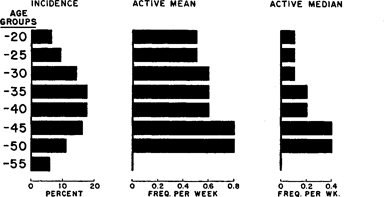
Figure 75. Active incidence, mean, median: experience in extra-marital coitus, by age
Data from Table 114 .
Incidence of Orgasm . In the available sample, about 85 per cent (in most groups 78 to 100 per cent) of all those who were engaging in extra-marital activity were responding, at least on occasion, to orgasm (compare the incidences of experience and orgasm in Table 114 ). For most age groups the incidences of response were about the same as those in marital coitus.
On the other hand, comparisons of the median frequencies of experience and of experience to the point of orgasm indicate that orgasm in the extra-marital relationships had occurred in a high proportion of the contacts (Table 114 ). In some cases, this had been more often than those same females were reaching orgasm in their marital coitus. Some of the females had experienced multiple orgasms, and the total number of orgasms had actually exceeded the number of contacts in some of the groups. Selective factors may have been involved, and the more responsive females may have been the ones who had most often accepted extra-marital coitus; but the high rate of response appears to have depended also on the fact that the extra-marital experience had provided a new situation, a new partner, and a new type of relationship which had been as stimulating to some of the females as it would have been to most males. Some females who had never or rarely reached orgasm with their husbands had responded regularly in their extra-marital relationships (p. 432).
Frequency . In that segment of the sample which was having extramarital coitus (the active sample), the frequencies had begun at the rate of once in ten weeks (0.1 per week) in the married teen-age and twenty-year-old groups (Table 114 , Figure 75 ). They had steadily increased in the later age groups. By the forties, the extra-marital coitus was occurring once in two to three weeks for those who were having any experience at all. This means that the active median frequencies of the extra-marital coitus were of about the same order as the active median frequencies of masturbation and twice as high as the frequencies of nocturnal dreams in marriage. The frequencies of the extramarital coitus were in actuality second only to the frequencies of marital coitus in the sample of middle-aged and older married females.
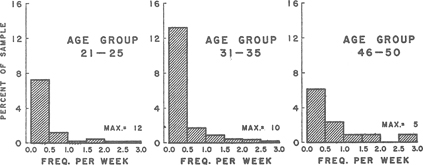
Figure 76. Individual variation: frequency of experience in extra-marital coitus
Each class interval includes the upper but not the lower frequency. For incidences of females not having extra-marital coitus, see Table 114 .
Because there were some individuals in each age group who were having extra-marital experience much more frequently than the average female in the sample, the active mean frequencies were much higher than the active median frequencies. The active mean frequencies had begun at once in two weeks (0.5 per week) among the teenaged, married females, and had risen to about once in eight or nine days (0.8 per week) among the females in their forties (Table 114 , Figure 75 ).
However, since the incidences of the extra-marital coitus were relatively low, the mean frequencies for the total sample, including those who were having and those who were not having experience, were very low. They had not averaged more than one extra-marital contact in something like ten weeks (the total mean frequencies), even during their peak between the ages of thirty and forty (Table 114 ).
Sporadic Nature of Frequency . There are few types of sexual activity which occur more irregularly than extra-marital coitus. This is because the opportunities to make such contacts usually occur only sporadically, and it is often difficult to find the time and place where the coitus may be had without the spouse or someone else becoming aware of the activity. Married persons may find more difficulty in arranging their non-marital activities than single persons find in arranging their pre-marital activities. Moreover, many married persons sharply limit their extra-marital activities in order to avoid emotional relationships which might break up their marriages.
Consequently the average frequencies shown in our calculations are misleading if they suggest that the extra-marital contacts had occurred with any weekly or monthly regularity. It is a prime weakness of statistical averages that they suggest a regularity in the occurrence of activities which do not actually occur with any regularity. A dozen sexual contacts which are made in two weeks of a summer vacation may show up as frequencies of once per month for the whole of a year, and such an even distribution of activity does not often occur. It is more usual to find several non-marital contacts occurring in the matter of a few days or in a single week when the spouse is away on a trip, or when the female is traveling and putting up at a hotel, or at a summer resort, or on an ocean voyage, or visiting at a friend’s home; and then there may be no further contacts for months or for a year or more. Only a smaller proportion of the females in the sample had ever developed regular and long-time relationships with males who were not their husbands.
Among the females in the available sample, the highest average frequencies of extra-marital coitus had occurred in the twenties, when three individuals were averaging seven contacts, one was averaging twelve, and one was averaging nearly thirty contacts per week over a five-year period. The maximum frequencies for particular individuals had dropped in the older groups. By fifty years of age, only one female in the total sample of 261 was having extra-marital coitus with a frequency which averaged more than three times per week (Figure 76 ). Just as with pre-marital coitus, the high frequencies were often attained by assured and socially effective individuals who had not been emotionally disturbed by their departures from the social code and who, therefore, had not gotten into difficulties because of their non-marital sexual activities.
Percentage of Total Outlet . Because of the relatively low incidences and low average frequencies of the extra-marital coitus, only a relatively small proportion of the sexual outlet of the total female sample had been derived from that source. Such activity had accounted for only 3 per cent of the orgasms of the females who were in their early twenties, but an increasing proportion of the outlet in the later age groups, until 13 per cent of the outlet had come from the non-marital activity by the late forties (Table 114 ). At that age in many of the marriages there had been some drop in the frequencies of the marital coitus, and the female who was still as responsive as or even more responsive than she had been in her earlier years had become more inclined to accept extra-marital coitus as a substitute for her reduced marital outlet.
There had been only minor differences in the accumulative incidences of extra-marital coitus among the females of the different educational levels (Table 115 ). Some 31 per cent of the females in the college sample had had some extra-marital coitus by age forty. Some 27 per cent of those who had done graduate work, and about 24 per cent of those who had gone into but not beyond high school had had such experience. The differences had not been great. 18
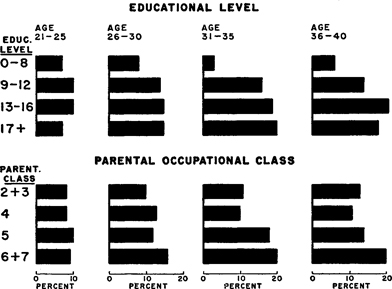
Figure 77. Active incidence: experience in extra-marital coitus, by educational level and parental occupational class
Data from Tables 116 and 117 .
The active incidences had hardly differed among the females of the several educational levels during their late teens (Table 116 ), but after age twenty-five the limited grade school sample showed definitely lower incidences than the rest of the sample (Table 116 , Figure 77 ).
The active incidences of the extra-marital coitus had steadily become higher in the older age groups, often because of the more deliberate acceptance of such activity among the older husbands and wives, especially in the better educated groups.
None of the differences in the average frequencies of the extra-marital coitus seemed to have been related in any significant way with the educational backgrounds of the females in the sample.
In the late teens, the active incidences of extra-marital coital experience and orgasm had not significantly differed among the females in the sample who had come from laborers’ homes, from the homes of skilled mechanics, and from the homes of lower and upper white collar and professional groups. But after age twenty-five more of the females who had come from upper white collar and professional homes were having extra-marital coitus, and extra-marital coitus in which they had reached orgasm (Table 117 , Figure 77 ).
The average frequencies of the extra-marital coitus had not varied in any way which seemed significantly correlated with the occupational classes of the homes in which the females had been raised.
The number of married females who were ultimately involved in extra-marital coitus (the accumulative incidences), and the number who were involved in any particular five-year period (the active incidences), appear to have been more or less markedly affected by the increased acceptance of sexual activities which began in this country with the generation that was born immediately after the turn of the century and which was, therefore, sexually most active immediately after the first World War or in the 1920’s (Tables 119 , 120 , Figures 78 , 79 ).
The accumulative incidences of extra-marital coitus among the females in the sample who were born before 1900 had reached 22 per cent by forty years of age. The incidences among the females who were born in the first decade after 1900 had reached 30 per cent by that same age. The later generations seem to be maintaining that level of incidence. 19
The lowest active incidences of extra-marital coitus had been among the females who were born before 1900. Most of the groups born after that showed a somewhat and, in many instances, a markedly increased incidence (Table 120 , Figure 79 ). For instance, in the sample of females between twenty-one and twenty-five years of age, 4 per cent of the generation that was born before 1900, but 8 per cent of those who were born in the first decade after 1900, had been involved in extramarital coitus. For the age group twenty-six to thirty, the figures were 9 per cent for the older generation and 16 per cent for the next generation. These increased active incidences of extra-marital coitus had paralleled the increases which had occurred in pre-marital petting (p. 244) and pre-marital coitus (p. 301) in the post-war generation of American females.
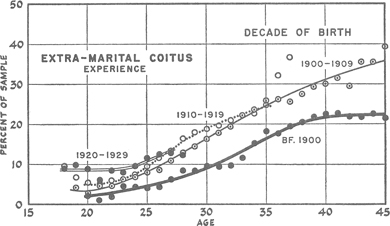
Figure 78. Accumulative incidence: experience in extra-marital coitus, by decade of birth
Data from Table 119 .
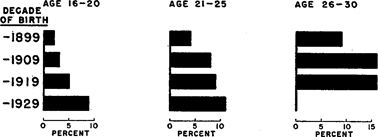
Figure 79. Active incidence: experience in extra-marital coitus, by decade of birth
Data from Table 120 . Incidence for ages 26–30 in youngest generation not shown because their marriages are of such short duration that data are incomplete.
There were, however, no consistent differences in the active median frequencies of extra-marital coitus among the females of the several generations in the sample. It is important to note again, as we already have in connection with the other sexual activities which became more prevalent after the first World War, that the increases in extra-marital coitus lay in the number of females who were involved, and not in any increase in the frequencies with which the average female had had experience.
The incidences of the female’s extra-marital coitus in particular periods of her marriage (the active incidences) (Table 118 ), and the frequencies with which she had had such coitus (the active median frequencies), did not seem to have been affected by the age at which she had turned adolescent.
The active incidences of extra-marital coitus had been more affected by the religious backgrounds of the females in the sample than by any other factor which we have examined. In every group in which we have sufficient cases for comparing females of different levels of religious devoutness, the lowest incidences of extra-marital coitus had occurred among those who were most devoutly religious, and the highest incidences among those who were least closely connected with any church activity. This was true of all the Protestant, Jewish, and Catholic groups in the sample. The differences in incidences were well enough marked in the younger age groups, but they become even more striking in the older Protestant groups. For example, in the Protestant groups aged twenty-one to twenty-five, some 5 per cent of the religiously active females had had extra-marital coitus, while 13 per cent of the inactive group had had such experience. But during the early thirties the differences lay between 7 per cent for the active Protestants and 28 per cent for the inactive Protestants (Table 121 , Figure 80 ). 20
While the frequencies of extra-marital experience had varied in the different groups, the variation did not show consistent trends which would warrant the opinion that the differences were related to the degree of religious devotion.
The times and places and detailed circumstances of extra-marital relationships have been the subject of so much literature throughout written history and fiction, that they need little additional analysis in the present context. Because of their previous marital experience, those who engage in extra-marital coitus usually see to it that the contacts are had under conditions which are similar to those usual in marital contacts. 21
Partners . The extra-marital partners of the females in the sample had, for the most part, been married males somewhat near the females in age; but sometimes they were younger or older males who had not been married or who were widowed or divorced. Not a few of the younger, unmarried males had had their pre-marital coital experience with married females, some of whom were the aggressors in starting the relationships.

Figure 80. Active incidence: experience in extra-marital coitus, in Protestant groups
Data from Table 121 .
Up to the time at which they contributed their histories, some 41 per cent of the females in the active sample had confined their extra-marital coitus to a single partner; another 40 per cent had had contacts with something between two and five partners (Table 122 ). This means that 19 per cent had had more than five partners and some 3 per cent had had more than twenty partners in their extra-marital relationships. 22 This is a somewhat higher degree of promiscuity than we found in the pre-marital coital histories, primarily because more years had been involved in the extra-marital activity.
Number of Years Involved . Of those females in the sample who had had any experience at all, nearly a third (32 per cent) had had extramarital coitus ten times or less, up to the date at which they contributed their histories to the present study (Table 123 ). Some 42 per cent had confined their activity to a single year or less; nearly a quarter (23 per cent) had confined it to two or three years. About a third (35 per cent) had had the coitus for some four years or more, including 10 per cent who had carried on their extra-marital relationships for more than ten years and in a few instances for more than twenty years.
The length of time over which extra-marital coital activities had been carried on and the number of partners involved were, of course, dependent on the number of years that the females had been married. At the time she contributed her history, the median female in the sample was 34 years old, and had been married 7.1 years (12.5 years among those who had had extra-marital coitus). If the females in the sample had been married longer, they would have had more extensive extramarital histories. Basing the calculations on the number of years that the females in the active sample had been married, we find that 36 per cent of those who had been married six to ten years had had extramarital coitus one to ten times; but among those who had been married over twenty years, only 23 per cent had been so confined in their experience (Table 123 ). Among those in the active sample who had been married six to ten years, 4 per cent had been having extra-marital coitus for six to ten years; but among those who had been married more than twenty years, 19 per cent had been having extra-marital coitus for as long a period of years, and 31 per cent had been having it for more than ten years.
Extra-Marital Petting . There were not a few of the married females and males in the sample who had accepted extra-marital petting even though they had refused to accept vaginal coitus. Such extra-marital petting seems to have increased within recent years, 23 although we do not have sufficient data to establish this point statistically. However, such petting is not confined to younger persons, for it occurs not infrequently in middle-aged histories and even in some of the older married histories. Just as with pre-marital petting, extra-marital petting is accepted because of the satisfactions which are peculiar to it, or in order to avoid a possible pregnancy, or sometimes because the available facilities are inadequate for coitus but sufficient for petting. In fact, at dinner parties, cocktail parties, in automobiles, on picnics, and at dances, a considerable amount of public petting is allowed between married adults when coitus would be unacceptable. Apparently petting is considered less immoral than coitus, even though the petting techniques may be as effective in bringing erotic response and orgasm. Extra-marital petting is not infrequently carried on in social groups which may include the female’s husband, and he would usually be less inclined to allow the extra-marital relationships if coitus were involved.
Unfortunately our record on extra-marital petting is incomplete, for we did not realize the extent of such activity when this study first began. Information on this point is available, however, on 1090 of the married females in the sample. Of these, some 16 per cent had engaged in extra-marital petting although they had never allowed extra-marital coitus.
The techniques of the extra-marital petting are, of course, identical with those which are used in pre-marital petting (pp. 251 ff.) and in the petting which precedes coitus both in marital (p. 361) and in nonmarital (p. 311) relationships. Of those females who had done extramarital petting without coitus, more than half had accepted breast and genital contacts. In some cases they had accepted mouth-genital contacts. Something short of 15 per cent of the females in the sample had reached orgasm in this extra-marital petting, including 2 per cent who had petted to orgasm although they had never allowed extra-marital coitus. The accumulative incidences of all these activities would undoubtedly have proved to be higher, if our data had been more complete.
Relation to Pre-Marital Coitus . Among the 514 females in the sample who had had extra-marital coitus up to the date at which they contributed their histories, over 68 per cent had also had coitus before marriage (Table 122 ). Since only 50 per cent of all the married females in the sample had had pre-marital coitus, it would appear that the premaritally experienced females were somewhat more inclined to accept coitus with males other than their husbands after marriage.
To put it in another way, 29 per cent of the females with histories of pre-marital coitus had had extra-marital coitus by the time they contributed their histories to this study, but only 13 per cent of those who had not had pre-marital coital experience.
This greater inclination of the females with pre-coital experience to accept extra-marital coitus after marriage, is even more strikingly shown by the accumulative incidences of experienced females, calculated as follows:
| By age | % of sample with extra-mar. coitus | Number of cases | ||
| FEMALES WITHOUT PRE-MAR. COITUS | FEMALES WITH PRE-MAR. COITUS | FEMALES WITHOUT PRE-MAR. COITUS | FEMALES WITH PRE-MAR. COITUS | |
| 35 | 16 | 33 | 513 | 399 |
| 40 | 20 | 39 | 364 | 207 |
| 45 | 20 | 40 | 225 | 87 |
These correlations between pre-marital and extra-marital experience may have depended in part upon a selective factor: the females who were inclined to accept coitus before marriage may have been the ones who were more inclined to accept non-marital coitus after marriage. A causal relationship may also have been involved, for it is not impossible that non-marital coital experience before marriage had persuaded those females that non-marital coitus might be acceptable after marriage. 24
However, the females who had had pre-marital coitus. seemed to have been no more promiscuous in their extra-marital relationships than the females who had had no pre-marital coitus (Table 122 ). Among those who had had coitus before they were married, 81 per cent had had extra-marital contacts with one to five partners; and among those who had had no pre-marital experience, 80 per cent had had coitus with that number of partners.
In nearly all societies and all moral codes, everywhere in the world, extra-marital coitus is restricted more severely than pre-marital coitus. 25 The Jewish, Mohammedan, and more ancient codes attached considerable significance to the virginity of the female at the time of marriage; but the morality of having coitus after marriage with an individual who was not one’s spouse was a matter of still more serious concern. In a general way this is true of Christian codes and of the Anglo-American law that grew out of them.
Anglo-American Law . The specific legal restrictions on extra-marital coitus, or adultery as it is known in Anglo-American law, largely originate in Jewish and Roman codes, but acquire their force more particularly from the Catholic Church codes which allow fewer exceptions than the original Jewish codes. 26 While there is a general prohibition of extra-marital coitus in Jewish law, there were exceptional circumstances which made such activity acceptable, As we have seen, the code allowed and even required extra-marital activity of the husband whose wife was sterile, and required the male to take unto himself as an additional wife the wife of his brother who had died. 27
American law has tended toward the proscription of all extra-marital sexual relationships; but in recognition of the realities of human nature, the penalties for adultery in most states are usually mild and the laws are only infrequently enforced. In 5 of the states the maximum penalty is a fine. There are 3 states which attach no criminal penalty at all to adultery, but civil penalties may be involved in these and in many other states. 28 In every state of the Union proof of adultery is allowed as sufficient grounds for divorce. Adultery is often taken as evidence of desertion or failure to support or a contribution to the delinquency of the children in the home. Both females and males may sometimes be penalized in this indirect fashion. In some states the right of the female to share in the husband’s property may be threatened by her adulterous behavior. The broadest definitions of adultery and the heaviest penalties are concentrated in the northeastern section of the United States, all 10 of those states being among the 17 which may impose prison terms for a single act of extra-marital coitus.
In actual practice, such extra-marital coitus is rarely prosecuted because its existence rarely becomes known to any third party. Even when it does become known, the matter is rarely taken to criminal court. Most of the cases which we have seen in penal institutions were prosecuted because of some social disturbance that had grown out of the extra-marital activity, as when a wife had complained, or when the family had been neglected or deserted as a result of the extra-marital relationships, or when arguments, physical fights, or murder was the product of the discovery of the relationships. Not infrequently the prosecutions represented attempts on the part of neighbors or relatives to work off grudges that had developed over other matters. In this, as in many other areas, the law is most often utilized by persons who have ulterior motives for causing difficulties for the non-conformant individuals. Not infrequently the prosecutions represent attempts by sheriffs, prosecutors, or other law enforcement officers to work off personal or political grudges by taking advantage of extra-marital relationships which they may have known about and ignored for some time before they became interested in prosecuting. In Boston, which is the only large city in which there is an active use of the adultery law, the statute appears to serve chiefly as a means of placing heavier penalties on simple prostitution. 29
In some 14 states, which include a third of the total population of the country, the law specifies that adultery is punishable only when it represents regular contacts or notorious or open cohabitation between two persons who are not lawfully wedded as spouses. 30 Higher courts in such states have consistently pointed out that lone or occasional contacts are not covered by the law. However, in dealing with cases which do not have experienced attorneys to defend them, the lower courts and law enforcement officers in general usually ignore these qualifications in the law.
Social Attitudes . There is a surprising paucity of any open and frank discussion of extra-marital coitus in the serious literature. 31 Public opinion in regard to such coitus represents a mixture of professed disapproval, and spite and malice in which a considerable undercurrent of envy and suppressed desire may become apparent. As we have seen, this envy is more often apparent in the male. The female is more often tolerant of other persons having extra-marital coitus unless it concerns her own spouse. Then her disapproval may represent envy of the female who has distracted her husband’s attention, or a general moral disapproval of all such non-marital activity. More often it reflects some fear that the extra-marital relationships will interfere with her own marriage.
As with other types of sexual activity, the most serious objections to extra-marital coitus come from females and males who have never had such experience. Those who have had experience are more often inclined to indicate that they intend to have more. In the sample, when the extra-marital experience had been satisfactory and had not gotten the females into personal or social difficulties, most of the experienced individuals were inclined to continue their activities.
Thus, among the married females in the sample who had not had extra-marital experience, some 83 per cent indicated that they did not intend to have it, but in a sample of those who had had extra-marital experience, only 44 per cent indicated that they did not intend to renew their experience (Table 124 , Figure 81 ). Some 5 per cent of those who had not had extra-marital coitus indicated that they wanted to have it, while another 12 per cent indicated that they might at some time consider the possibility of having it. This gave a total of 17 per cent who were not seriously opposed to the idea. In contrast, however, among those who had already had extra-marital coital experience, some 56 per cent indicated that they intended to have more or would consider the possibility of having more. 32
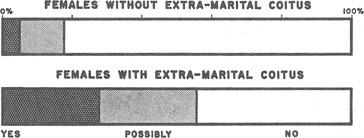
Figure 81. Intent to have extra-marital coitus
Based on females married at time of interview. Data from Table 124 .
To weigh the social significance of extra-marital sexual activity will require considerable objectivity in order to avoid, on the one hand, the traditional moral interpretations and, on the other hand, biases which are introduced by the human animal’s desire for a variety of sexual experience. Certainly any scientific analysis must take into account the fact that there are both advantages and disadvantages to engaging in such activity. We do not yet have sufficient data to undertake an overall appraisal of the problem, but the following aspects of extra-marital activity are pointed up by the experience of the females who have contributed histories to this study:
1. Extra-marital coitus had attracted some of the participants because of the variety of experience it afforded them with new and sometimes superior sexual partners. 33 As in pre-marital coitus, the males in the extra-marital relationships had usually engaged in more extensive courting, in more extended sex play, and in more extended coital techniques than the same males had ordinarily employed in their marital relationships. In consequence many of the females had found the extramarital coitus particularly satisfactory. It is true that 24 per cent of the females in the sample had not reached orgasm in their extra-marital coitus as often as they had reached it in their marital coitus; but 34 per cent had reached it with about equal frequency in the two types of activity; and 42 per cent reported that orgasm had occurred more often in the extra-marital relations.
2. In many instances the female or male had engaged in the extra-marital coitus in a conscious or unconscious attempt to acquire social status through the socio-sexual contacts.
3. In some instances the extra-marital coitus had been accepted as an accommodation to a respected friend, even though the female herself was not particularly interested in the relationship.
4. In some instances the female or male had engaged in extra-marital coitus in retaliation for the spouse’s involvement in similar activity. Sometimes the extra-marital activity was in retaliation for some sort of non-sexual mistreatment, real or imagined, by the other spouse.
5. In some instances, both among the females and males, the extramarital coitus had provided a means for the one spouse to assert his or her independence of the other, or of the social code. 34
6. For some of the females the extra-marital relationships had provided a new source of emotional satisfactions. Some of them had found it possible to develop such emotional relationships, while maintaining good relationships with their husbands. Others, however, had found it impossible to share such emotional relationships with more than one partner. In a culture which considers marital fidelity to be the symbol and proof of such other things as social conformance, law abidingness, and love, many of the females had found it difficult to engage in nonmarital sexual activities without becoming involved in guilt reactions and consequent social difficulties. 35 The females who had accepted their extra-marital activity as another form of pleasure to be shared, did not so often get into difficulties over their extra-marital relationships.
7. Not infrequently the extra-marital activities had led to the development of emotional relationships which had interfered with the relations with the lawfully wedded spouses. This had caused neglect and disagreement which had seriously affected some of the marriages. This is the aspect of extra-marital activity which most societies, throughout the world, have been most anxious to control. We doubt whether such disturbances are inevitable, for there are cases of extramarital relationships which do not seem to get into difficulties. There are strong-minded and determined individuals who can plan and control their extra-marital relationships in such a way that they avoid possible ill consequences. In such a case, however, the strong-minded spouse has to keep his or her activity from becoming known to the other spouse, unless the other spouse is equally strong-minded and willing to accept the extra-marital activity. Such persons do not constitute a majority in our present-day social organization.
8. Sometimes sexual adjustments with the spouse had improved as a result of the female’s extra-marital experience. 36
9. Extra-marital relationships had least often caused difficulty when the other spouse had not known of them. They had most often caused difficulty at the time that the spouse first discovered them. Some of the extra-marital relationships had been carried on for long periods of years without ill effects on the marital adjustments; but when the other spouse discovered them, difficulties and in some instances divorce proceedings had been immediately begun. In such instances, the extramarital coitus had not appeared to do as much damage as the knowledge that it had occurred. The difficulties were obviously compounded by the attitudes of our culture toward such non-marital activity.
The females who had had extra-marital coitus believed that their husbands knew of it, or suspected it, as follows:
| Percent | |
| Husband knew | 40 |
| Husband suspected | 9 |
| Husband presumably did not know | 51 |
| Number of cases | 470 |
The females in the sample reported as follows on the difficulties which developed when their husbands learned of or suspected their wives’ extra-marital activities:
| Percent | |
| Serious difficulty | 42 |
| Minor difficulty | 16 |
| No difficulty | 42 |
| Number of cases | 221 |
Adding these cases in which there had been no difficulty to the cases in which the husbands did not know of the extra-marital relationships, it is a total of 71 per cent for whom no difficulty had yet developed. 37
It is, of course, not impossible that the extra-marital activities may have become sources of marital difficulties at some later date. We have seen instances of what appeared to be a frank and whole-hearted acceptance of the spouse’s extra-marital activity when it first began and even for some period after it had begun, with considerable conflict growing out of the activity at some later period. Sometimes extraneous circumstances, such as a new economic situation, the development of some insecurity on the part of the other spouse, or the appearance of a new extra-marital partner, had reopened the issues of extra-marital relationships some five or even ten years after they had begun.
10. Among 16 females we have a record of 18 pregnancies resulting from the extra-marital coitus. The actual incidences of such pregnancies are probably higher than that. In most cases the pregnancies had been terminated by abortions. In some instances the child had been raised in its mother’s home, either with or without the husband’s knowledge of the child’s parentage. In other instances, the pregnancy had led to a divorce.
11. There is a not inconsiderable group of cases in the sample in which the husbands had encouraged their wives to engage in extramarital activities. This represented a notable break with the centuries-old cultural tradition. In some instances it represented a deliberate effort to extend the wife’s opportunity to find satisfaction in sexual relations. In not a few instances the husband’s attitude had originated in his desire to find an excuse for his own extra-marital activity. What is sometimes known as wife swapping usually involves this situation. In another group of cases the husband had encouraged extra-marital relations in order to secure the opportunity for the sort of group activity in which he desired to participate. Sometimes his interest in group participation involved a homosexual element which was satisfied by seeing another male in sexual action, or which he, on occasion, had satisfied by extending his contacts to the male who was having coitus with his wife. Much the same elements were involved when the husband sought the opportunity, through peeping, to surreptitiously observe his wife’s extra-marital coitus. In some lower level histories, but infrequently in the better educated or economically better placed groups, the husband had encouraged his wife’s extra-marital activity as a form of prostitution which had added to the prestige or the financial income of the family. There were a few instances of husbands who had encouraged their male friends and strangers to have coitus with their wives because of the sadistic satisfaction which they had obtained by forcing their wives into such relationships.
It should, however, be emphasized again that most of the husbands who accepted or encouraged their wives’ extra-marital activity had done so in an honest attempt to give them the opportunity for additional sexual satisfaction.
12. Extra-marital coitus had figured as a factor in the divorces of a fair number of the females and males in our histories. We have data on 907 individuals (female and male) who had had extra-marital experience and whose marriages had been terminated by divorce. We have the subjects’ judgments of the significance of their extra-marital coitus in 415 cases. In nearly two-thirds (61 per cent) of these cases, the subject did not believe that his or her own extra-marital activity had been any factor in leading to that divorce (Table 125 ). Some 14 per cent of the females and 18 per cent of the males believed that their extra-marital experience had been prime factors in the disruption of the marriage, and something between 21 and 25 per cent more believed that it had been a contributing factor. It is to be noted, however, that these were the subjects’ own estimates of the significance and, as clinicians well know, it is not unlikely that the extra-marital experience had contributed to the divorces in more ways and to a greater extent than the subjects themselves realized.
The subjects’ estimates of the importance of the spouses’ extra-marital activity were handicapped, both in the case of the females and the males, by the fact that they were ignorant in perhaps half of the cases that the extra-marital activity had occurred (p. 434).
It is particularly notable that the males rated their wives’ extramarital activities as prime factors in their divorces twice as often as the wives made such evaluations of their husbands’ activities. Some 51 per cent of the males considered that their wives’ non-marital relations had been chief factors in precipitating the divorces, and another 32 per cent considered them factors of some importance. Only 17 per cent considered them minor factors (Table 125 ). In contrast to this, the females considered that the husbands’ extra-marital activities were prime factors in only 27 per cent of the divorces, moderate factors in 49 per cent, and minor factors in a full 24 per cent. It may be a fact that the males’ extra-marital activities do not do so much damage to a marriage, or the wives may be more tolerant of their husbands’ extramarital relations, or the wives may not comprehend the extent to which the male activities are actually affecting the stability of their marriages. Contrariwise, like the true mammal that he is, the male shows himself more disturbed and jealous and more ready to take drastic action if he discovers that his wife is having extra-marital relations.
These data once again emphasize the fact that the reconciliation of the married individual’s desire for coitus with a variety of sexual partners, and the maintenance of a stable marriage, presents a problem which has not been satisfactorily resolved in our culture. It is not likely to be resolved until man moves more completely away from his mammalian ancestry.
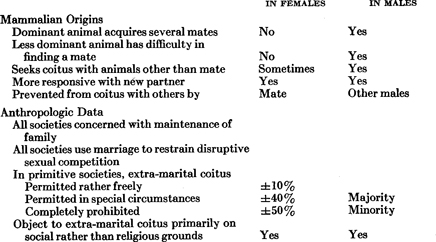
Table 114. Active Incidence, Frequency, and Percentage of Outlet Extra-Marital Coitus
By Age
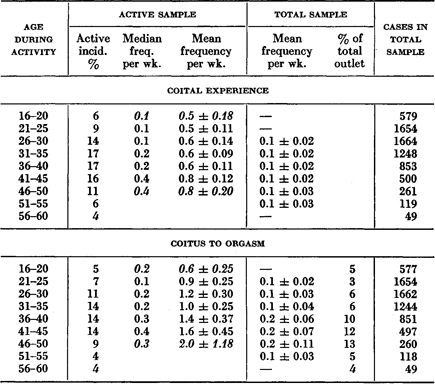
Italic figures throughout the series of tables indicate that the calculations are based on less than 50 cases. No calculations are based on less than 11 cases. The dash (—)indicates a percentage or frequency smaller than any quantity which would be shown by a figure in the given number of decimal places.
Table 116. Active Incidence and Percentage of Outlet: Extra-Marital Coitus
By Educational Level
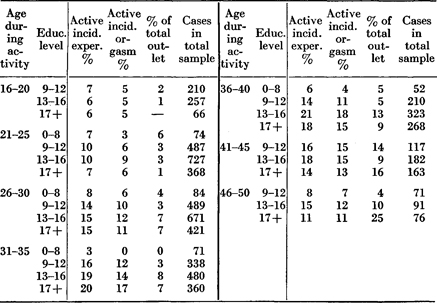
Table 118. Active Incidence and Percentage of Outlet: Extra-Marital Coitus
By Age at Onset of Adolescence
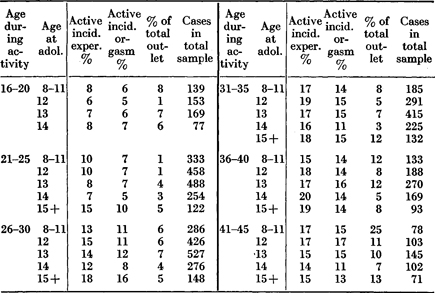
Table 120. Active Incidence and Percentage of Outlet: Extra-Marital Coitus
By Decade of Birth
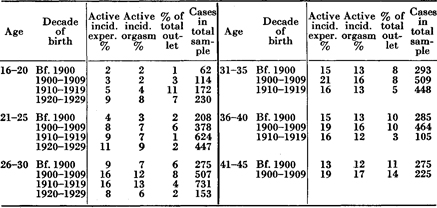
Table 123. Number of Years Involved: Extra-Marital Coital Experience
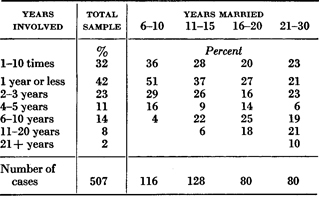
“Years married” represents the number of years that the spouses actually lived together.
Table 125. Reported Significance of Extra-Marital Coitus in Divorce
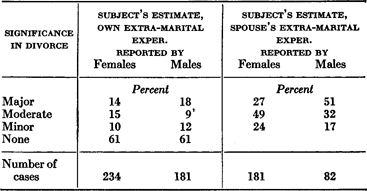
1 An excellent description of animal territories, and the possessive attitudes toward them, is in: Hediger 1950:7–18.
2 Escaping the anger of an offended mate by offering coitus is described by: Hamilton 1914:304–305. Zuckerman 1932:228.
3 One of the few cases of females fighting over the possession of a male, is recorded for the monkey by: Hamilton 1914:304. Carpenter 1942:passim believes that the female gibbon drives other adult females away from her mate.
4 That there may be a renewal of sexual activity among bulls following the introduction of a new bull is common knowledge among cattle breeders, and we have frequently observed such behavior.
5 The increased vigor in copulation, and the reduction of foreplay which characterizes sexual activity with a new partner, are described for monkeys in: Hamilton 1914:303. Kempf 1917:143.
6 The rise from youthful bachelorhood to adult mateship, and the subsequent return to bachelorhood, is well known for animals such as the elephant and stallion. It is described for the baboon by: Zuckerman 1932.
7 The omnipresent desire for extra-marital coitus is noted, for instance, by Reichard in Boas 1938:435 (“There is probably no tribe in which formal marriage alone is sexually satisfactory”). The checking of this desire by various social devices is noted by Linton 1936:136 (“All societies inhibit the male’s tendency to collect females to some degree, setting limits to the competition for them and, through marriage, assuring the male of the possession of those which he has already gathered”).
8 Gorer 1938:170.
9 Ashley Montagu 1937:236.
10 Ford 1945:93.
11 Murdock 1949:261.
12 Malinowski in Marcuse 1928:104.
13 This lesser social concern in the majority of primitive societies over extra-marital coitus for the male is noted by: Ford 1945:29–30.
14 Using the “Cross Cultural Survey” files, Ford 1945:29–30, 101, found under one-third of the societies permitting extra-marital coitus. In a later work, Ford and Beach 1951:113 estimated 39 per cent. Utilizing the same files, Murdock 1949:265 reports a smaller percentage but adds: “A substantial majority of all societies … permit extra-marital relations with certain affinal relatives.” Considering these sources and still ’additional data, and defining a “permissive” society as one which permits female extra-marital coitus under any situation, including wife-lending and orgiastic ceremonies or festivities, we arrive at our figures of 10 per cent and 40 per cent. A broad definition is imperative if one is to avoid such complications as arise, for example, in the case of the Yakut who are listed as forbidding female extra-marital coitus (Ford and Beach 1951:115), and who also demand extra-marital coitus for females in the form of wife-lending (Ford 1945:30).
15 The widespread practice of defloration or coitus with a bride by someone other than the groom, throughout European and derivative cultures, is the so-called “Jus primae noctis” or “Droit du seigneur.” Its history is excellently covered by: Schmidt 1881. Foras 1886. Westermarck 1922(1) :ch.5. The custom is also listed for almost a score of primitive groups, as in: Crawley 1927 (2) :66, 255
16 Covert toleration of female extra-marital coitus in societies forbidding such coitus, is not uncommon. See: Ford 1945:30. Ford and Beach 1951:116.
17 American data on incidences of extra-marital activities among females are also found in: Hamilton 1929:350. Dickinson and Beam 1931:313, 315, 394. Strakosch 1934:77. Glueck and Glueck 1934:432. Landis et al. 1940:97. Dearborn in Fishbein and Burgess 1947:168. Locke 1951:152. The findings in these studies range from the low figure of 1.2 per cent in Locke’s happily married sample to a 24 per cent figure in the studies of Hamilton and Glueck. The European studies show the following: Schbankov ace. Weissenberg 1924a:13 (6 per cent of 53 Russian students). Golossowker ace. Weissenberg 1925:176 30 per cent of 107 Russian students). Gurewitsch and Grosser 1929:535 18 per cent of 166 Russian female students). Gurewitsch and Woroschbit 1931:91 (8 per cent of over 1500 Russian peasant women, but 12 per cent in the 35–40 age group). Friede burg 1950:13 (10 per cent of 517 German women in a questionnaire survey). England ace. Rosenthal 1951:59 (18 per cent of British middle-class women).
18 In the several Russian studies (see footnote 17), the incidence of extra-marital coitus among peasant women is lower than the incidence among students, as in: Gurewitsch and Woroschbit 1931:91.
19 These changes in patterns of marital fidelity are commented on by: Kühn 1932: 228–229 (increase is product of freer life of women). Folsom 1937:720–723 (increase due to revaluation of importance of pleasure in sexual experience). Locke 1951:149–150 (reported no differences in incidences of extra-marital coitus among females born in four successive decades; but based his findings on an active sample of not more than 12 cases).
20 Friedeburg 1950:31 found an inverse relationship between the incidence of extramarital coitus and regularity of church attendance in a German survey of 579 males and females. The figures ranged from 9 per cent reporting extra-marital experience among those who attended church regularly, to 27 per cent reported by those who never attended church.
21 Sylvanus Duvall 1952:161 also recognizes that conditions for extra-marital coitus may be better than for pre-marital coitus.
22 Data on number of partners in extra-marital relations are also to be found in: Hamilton 1929:350–351 (among 24 females, 38 per cent had had only one partner). Gurewitsch and Woroschbit 1931:92 (among 1516 Russian peasant women, 53 J2er cent had had one. partner, 25 per cent had had two, 10 per cent had had three),
23 Bernard 1938:357 found 49 per cent of females and 59 per cent of males, among 500 college students, tolerant of extra-marital petting.
24 A positive relationship between pre-marital and extra-marital coital experience was also reported by: Hamilton 1929:346. Landis et al. 1940:98. Terman 1938:340 reported a similar correlation with desire for extra-marital relations.
25 This greater restriction on extra-marital coitus, in comparison to the restrictions on pre-marital coitus, is surveyed and documented in: Donohue 1931:4. Ohlson 1937:330. Ford and Beach 1951:115.
26 Extra-marital coitus is penalized in the ancient codes, some of which date back to the 2nd millennium B.C. See: Pritchard 1950:35, Book of the Dead. Pritchard 1950:160, Lipit-Ishtar law code (with some provisions for second wives). Pritchard 1950:171–172, Code of Hammurabi. Pritchard 1950:181–182, Middle Assyrian laws (including the following: “If he has kissed her [the wife of another], they shall draw his lower lip along the edge of the blade of an ax and cut it off”). Pritchard 1950:196, Hittite code. For the Jewish code, see Epstein 1948:201–214. Biblical references are plentiful, ranging from the specific prohibitions in Exodus 20:14, Leviticus 20:10, and Deuteronomy 22: 22, to the colorful descriptions in II Samuel 11 :4, Proverbs 7: 6–23, and Ezekiel 23:1–45. Also see the Koran pt.l8, ch. 24:2–20. For the Catholic code, see Davis 1946(2) :237–239.
27 Talmudic students searched assiduously for other special circumstances which might justify exceptions to the rule against extra-marital coitus—as, for instance, when a male, looking over a parapet, accidentally fell onto a passing female, and accidentally effected a genital union as he fell. In such a case the male would be absolved of any blame for having broken the rule against extramarital coitus. See the Talmud, Yebamoth 54a.
28 The states in which the maximum penalty for adultery is a fine are: Ky., Md., Tex., Va., and W. Va. The states in which there is no criminal penalty are: La., N. M. (but see §41–702 N.M.Stat. 1941), and Tenn. Also see Bensing 1951:67. In 6 states (Ia., Mich., Minn., N. D., Ore., and Wash.), adultery can be prosecuted only on the complaint of the spouse.
29 This use of the law in Boston is clearly evident from Ploscowe 1951:157, and from Reiman and Schroeter 1951:75.
30 The states in which the prosecution of adultery is limited to instances where there has been regular, notorious, or open cohabitation are: Ala., Ark., Calif., Colo., Fla., Ill., Ind., Miss., Mo., Mont., Nev., N. C., Ohio, and Wyo. In Arizona and Oklahoma, single acts can be prosecuted only on the complaint of the injured spouse.
31 The traditional social disapproval is reflected, for instance, in: Inge 1930:366–374. Neumann 1936:109. Fromme 1950:207–225. Sylvanus Duvall 1952:150–171, 292–296. More liberal interpretations may be found in: Bertrand Russell 1929:139–144. Guyon 1948:138. Haire 1948:195. Comfort 1950:103–105. Havelock Ellis 1952:84–90. That extra-marital coitus is less acceptable for females than for males is noted, for instance, in: Talmey 1910:241. Michels 1914:136,223. Kisch 1918(1):4–6.
32 Specific data on the female’s desire to have extra-marital coitus are also in: Davis 1929:409 (16 per cent). Hamilton 1929:368 (35 per cent). Terman 1938: 336 (27 per cent). Locke 1951:149 (4 per cent and 12 per cent). For surveys of attitudes, see: Davis 1929:356 (21 per cent of 955 women saw possible justifications for extra-marital relations). Hamilton 1929:364 (73 per cent of 100 married women saw possible justification). Bernard 1938:357–358 (80 per cent of 500 college males and females stated they would pardon one act of infidelity in their spouse). Friede burg 1950:13 (in German questionnaire survey, found 38 per cent approve some extra-marital relations). Lanval 1950: 123 (among 552 chiefly French and Belgian women, 36 per cent considered faithfulness after marriage unimportant).
33 That a low orgasm rate, or other dissatisfactions in marital coitus, may develop a desire for extra-marital coitus is implied by: Hamilton 1929:389, 395. Strakosch 1934:78. Terman 1938:337, 340, 387. But Landis et al. 1940:172 found wives with extra-marital experience (14 cases) had made fairly adequate sexual adjustments with their husbands.
34 Reasons for extra-marital coitus are also listed in: Hamilton 1929:362. Gurewitsch and Woroschbit 1931:92. Maslow 1942:279. Sylvanus Duvall 1952:158. These list such factors as unsatisfactoriness of the marital relationship, absence or illness of husband, financial advantage, desire for variety, need for emotional reassurance, emotional attachment to new partner, and attempt to help the marriage.
35 Landis et al. 1940:174 found fewer guilt reactions in extra-marital coitus than in pre-marital coitus.
36 An actual improvement of the marital relationship following extra-marital experience is also reported in: Landis et al. 1940:98 (in 4 cases out of 12). It is suggested by: Bell 1921:31. Folsom 1937:723. See also Pepys 1668: Nov. 14, who wrote that he had had coitus with his wife “as a husband more times since this falling out [twenty days ago] than in. I believe twelve months before. And with more pleasure to her than I think in all the time of our marriage before." Assertions that extra-marital relationships will inevitably do damage to a marriage are typified by the statement in: Kirkendall 1947:29.
37 Locke 1951:152 reported that 5 per cent of the happily married wives believed their mates knew or suspected that they had had extra-marital relations, while 17 per cent of the divorced wives believed so.